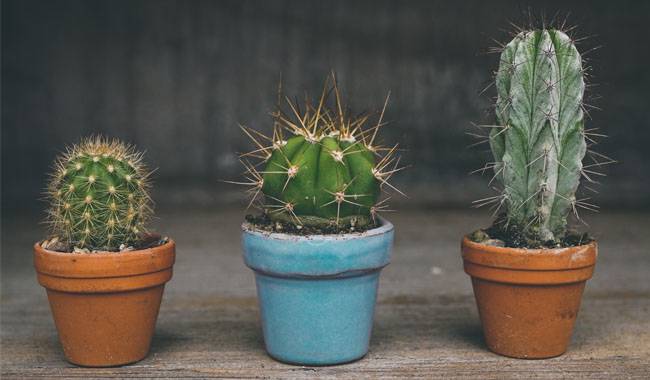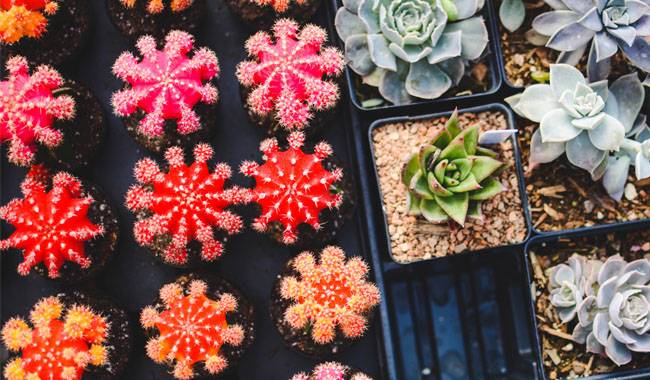
There’s a reason why many people grow cactus as a purely “green” indoor decoration: they require special conditions to establish flower buds. But for lovers of unique flowers that appear more colorful against a backdrop of thorny stems, any difficulty in arranging a proper rest will be more than rewarded. It is not necessarily the most dominant temperature in their overwintering process. Strong humidity contrasts, special lighting, and a radical change in general care – here is the key to the colorful blooms of your favorite cactus. There is also a possible reason for the absence of long-awaited blooms. You will learn how to grow cactus plants in ThumbGarden’s article.
THERE ARE DIFFERENT CACTUS
The only thing that different types of cacti have in common is the fear of over-watering and humidity. Too much and too frequent watering during the hot summer months can also ruin these fascinating plants. All plants of the cactus family, without exception, need to maintain at least half the soil humidity in winter. But that’s where the similarities end. And all the diversity of cacti comes into play, which determines whether and under what “conditions” they can flower.
Thick, handsome foliage and golden prickles mean that Cereus, Echinocactus, and Cleistocactus cannot flower at home until old age. Neither can color (or, more simply, dyed) mini cacti, which fill the shelves as colorful interior decorations.
To make it easier to “deal” with cacti and choose a dormancy strategy, it is easiest to divide them into two basic groups, overwintering cool and warm species, and remember that they are very different from each other.
- Classic desert or African cacti, with a dry and cool dormant period during the winter.
- Forests (South America) are surprisingly water-loving species with frequent flowering shifts and different care requirements.
Choosing the right species for which flowering conditions are created is the key to success. If moving to a cold environment (such as a cold hall or a sheltered balcony) is not a problem, you can choose a full range of indoor cacti. It is best to choose according to your taste and evaluate the species only from the point of view of decoration.
The popular luxury spheres Mammillaria and Rebucia require essentially similar conditions. However, if cooler areas of the house are “in short supply” and it is difficult to display cacti in comfortable temperatures and light, it is best to limit your choice to species that do not require cool conditions at all to establish flower buds.Ripsalis, Disocactus, Aporocactus, Gymnocalycium, Melocactus, and Zygocactus with Slumbergera grow at normal room temperature. Thus, there is a species for both lovers of magnificent Christmas trees and lovers of “breadcrumbs.”
It isn’t easy to distinguish which cacti do and do not need cool conditions to flower, but you can always ask the retailer or do some basic information about the species.
WHY DON’T CACTI BLOOM?
The most obvious reason for a beloved cactus not to flower is lack of coolness. If the temperature is too high for cacti that need cooler temperatures during their dormant period, no amount of care will allow them to produce buds and flowers. Mammillaria, Rebutia, and Co. overwinter at 41-59 °F (5-15°C) (the lower the temperature, the faster they flower).
If you have a drop in temperature from December and no fruit, a lack of care is causing poor flowering.
- constant temperature fluctuations, from hot to cold.
- violation of the “dry” regime – any watering (they are reduced to a minimum of soil moistening to loosen the soil once a month for the duration of the stay cool).
- incorrectly “converting” to overwintering (ideally, watering is gradually reduced starting in October and stopped in November before moving the plants to a new environment with a dry substrate)
- Too abrupt “exit” from dormancy – cacti should gradually adapt to light and should not be watered or fertilized immediately: spray the substrate carefully with warm water in early March and start watering less for a few weeks before returning to the normal spring/summer regime (fertilization should not be resumed within 2 weeks of the start of normal watering).
- Fertilize from August to March.
- Use organic nutrients.
- Fertilize too much in summer (or conversely, if the soil is thin, don’t fertilize at all).
- Over-watering in spring and summer and failure to maintain a light moisture regime during growth.
- Watering with warm water in winter and cold water in summer.
- Lack of light from spring to autumn, especially after coming out of dormancy: lighting should be as bright as possible; desert cacti prefer direct sunlight and forest cacti prefer soft diffused light; plants should be placed outside in semi-shade in summer.
- lack of fresh air in summer.
- Constant rotation relative to the light source (most desert cacti require tightening).
It is worth remembering to reduce lighting during the dormant period (although this is usually in winter).
WHY CACTI DO NOT BLOOM IN WARM CONDITIONS

For those cacti that bloom even indoors and do not require cool preservation during the rest period, the entire responsibility for blooming “lies” in the quality of care. After all, only the correct care – or, more precisely, the correct reduction of care – can stimulate the formation of buds. The reasons for the non-flowering of these species are
- inadequate reduction of watering (reduce it until the beginning of November, so as not to water the cactus until the beginning of March and not to allow the stems to wilt and wither – once a week or less often, with a minimum of water)
- over-fertilization (too frequent or concentrated in the summer, not stopping from August to March)
- Too high temperatures (close to the normal bloom preparation period for heaters above 68 °F (20°C) is not possible, even for warm-loving species; warm dormant periods should still be more than ten degrees Fahrenheit cooler than usual.
- lack of light after the first sign of emergence from a conditionally dry dormant period (given that all species prefer sunlight, except ‘Christmas trees,’ an increase from semi-shade to diffuse bright light, a move to a brighter windowsill or additional light is essential for fall, winter and early spring flowering)
- Inadequate light and ventilation in summer (access to fresh air is as important as optimal light conditions during active growth)
- Changes in the direction in relation to light sources, especially from the latter part of the dormant period.
- Lack of contrast between daytime and nighttime temperatures (the difference during the resting period should be at least 50 degrees Fahrenheit.
- Wrong care during the active vegetative period.
OTHER REASONS WHY CACTI DO NOT BLOOM
Suppose despite the correct reduction of care, the cactus does not flower. In that case, you should first check the plant for signs of pests and diseases, and check the quality and condition of the substrate as well as its permeability and air permeability. There is also the right size: if there is too much free soil, the cactus will not bloom; if the roots occupy the whole root ball and there is too little space, they will not bloom. And they don’t like pots that are too deep, even if they have a high drainage layer. Sometimes they don’t like plastic (all cacti like breathing containers) and have insufficient drainage holes.
Even if you exclude all the reasons, cacti may still not bloom. After all, sometimes purchased plants that have been artificially stimulated to extend their flowering time are exhausted and need a longer pause. And not all cacti bloom at a young age either. Give them time and provide them with ideal care, and the long-awaited blooms will come soon enough.







